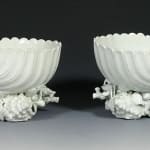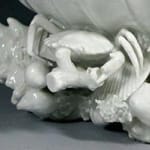

A rare Pair of Early Bow Shell Salts or Sweetmeat Dishes, Circa 1750-52
A pair of very fine Bow large shell salts or sweetmeat dishes, modelled with a deeply fluted shell resting on top of three conical shells, perhaps whelks, lavishly encrusted with smaller shells, clams, coral and the rope-like whelk egg casing on both the base and the large shell dish, with the addition of crabs amongst the smaller shells and seaweed on the bases.
The three shells forming the feet of the salts are a form of gastropod, probably cast from a actual specimen.
It is interesting to note the colour difference between the two pairs, cream and a bluish white, this feature also occurs on a group of extremely rare and early Lion models, the lionesses are of a bluer caste than that of the creamier Lions. It is suggested that this is as a result of the placing near the heat source within the kiln.
Join our mailing list
* denotes required fields
We will process the personal data you have supplied in accordance with our privacy policy (available on request). You can unsubscribe or change your preferences at any time by clicking the link in our emails.

